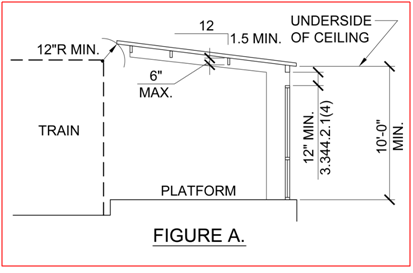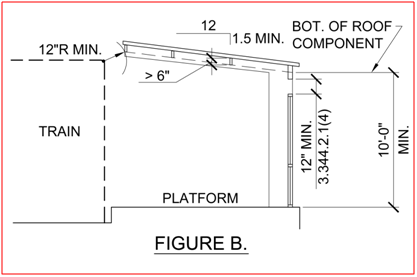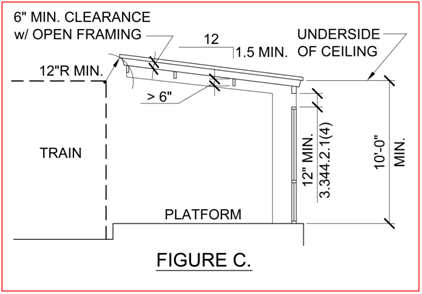23.85.344 NFPA Standard 130 Section 3.3.44 amended – Station.
Section 3.3.44 of NFPA Standard 130 is hereby amended to read as follows:
3.3.44 Station. A place designated for the purpose of loading and unloading passengers, including patron service areas and ancillary spaces associated with the same structure.
3.3.44.1 Enclosed Station. A station or portion thereof that does not meet the definition of an open station.
3.3.44.2* Open Station. A station that is constructed such that it is directly open to the atmosphere and smoke and heat are allowed to disperse directly into the atmosphere. Open stations shall conform to the design requirements of sections 3.3.44.2.1 through 3.3.44.2.2
3.3.44.2.1 – Roof/Canopy Extent. For a station to be considered “open to the atmosphere” the roof of the station shall comply with the following:
(1) There shall be no roof directly above the trainway for the entire length of the station.
(2) Individual roof segments covering the full width of the platform (within 36 inches of platform edge) shall not exceed 200 feet in length without a minimum separation of 20 feet from adjoining full width roof segments. For the purposes of determining canopy length, individual canopy segments covering the full width of the platform (within 36 inches of platform edge) spaced closer than 20 feet to each other shall be considered as one canopy.
Exception: In an open station provided with an automatic fire sprinkler system per NFPA 13, a roof, canopy, or ceiling extending the full width of the platform shall be permitted to be the full length of the platform.
Exception: Roof segments which remain farther than 36 inches from the platform edge may be the full length of the station.
(3) The underside of the ceiling shall be at a minimum height of 10 feet above the platform, with a minimum slope of 1.5:12 to facilitate smoke venting to the atmosphere. There shall be a minimum 12 inch clearance between the edge of the roof and the static envelope of a train. Roof components perpendicular to the roof slope with a depth no greater than 6 inches may project into the minimum height of the underside of the ceiling plane. (Fig. A)

The bottom of roof components perpendicular to the roof slope with a depth greater than 6 inches shall establish the height of the underside of the ceiling plane (Fig. B) unless there is a minimum 6 inch high gap between these components and the underside of the ceiling plane. (Fig. C)

The bottom of roof components shall comply with the minimum height requirements of the International Building Code.

(4) At side platform stations there shall be a minimum 12 inch high gap between the canopy/ceiling and solid walls/windscreens along the side opposite of the tracks for a minimum 60% of the length of the roof. (Fig. A, B, or C)
3.3.44.2.2 – Individual freestanding components (windscreen shelters, kiosks, etc.) on the passenger platform shall extend no closer than 12 inches to the underside of the roof/ceiling assembly or provide equivalent opening area to allow smoke to escape to the atmosphere.
3.3.44.2.3 – Retained Cut Stations. Portions of a station in a retained cut complying with 3.3.44.2.1 shall be considered as an open station. Where the station is covered with structures having a width greater than 20 feet crossing both the platforms and trainway with a minimum clearance of 16 feet above the platform to the underside of the body of the structure (excluding structural components) that portion of the station shall be provided with an automatic fire sprinkler system per NFPA 13 and continue to be considered an open station. Otherwise the covered portion shall be considered an enclosed station. Where a station is covered by a structure crossing the platform and trainway exceeding 200 feet in width, that portion of the station shall be considered an enclosed station.
3.3.44.2.4 – Opening Protection. Openings and the exterior walls of “open stations” (not including edges of trainways) shall also comply with the requirements of Table 602, Section 704.10 and Section 705 of the International Building Code.
(Ord. 6115 § 1, 2013.)